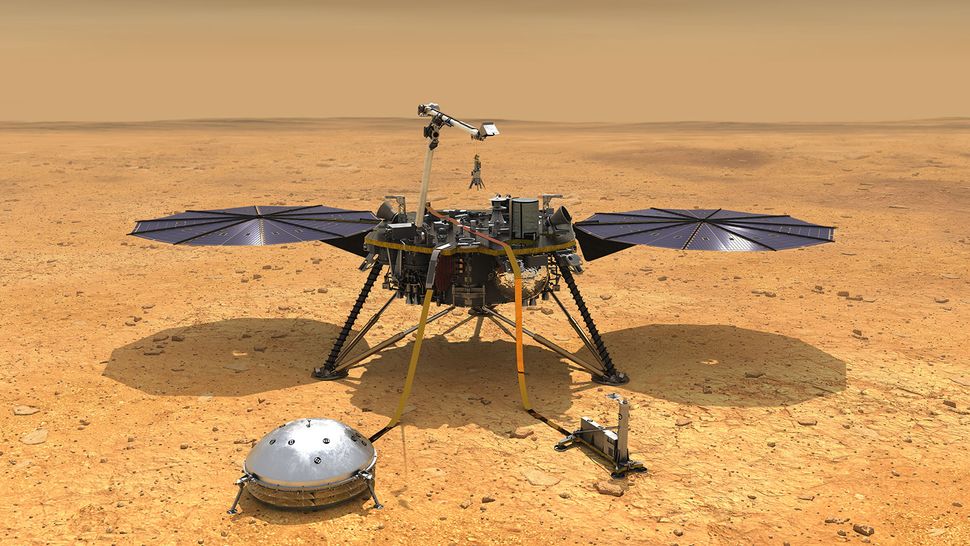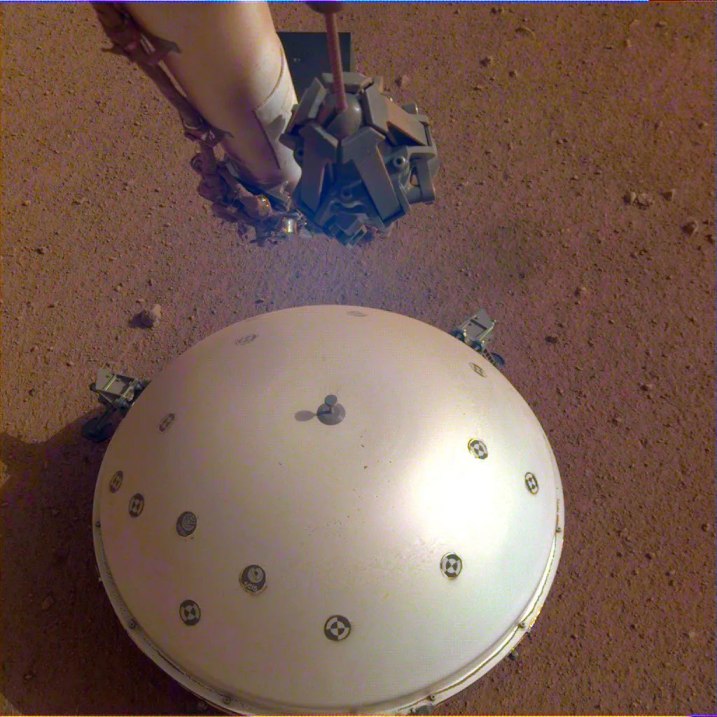The results suggest that the Red Planet experiences between 180 and 260 meteorite impacts per year, and these objects can be as small as basketballs, leaving craters eight meters (26 feet) across in the ground. Overall, the impact rate is two to ten times higher than predicted, depending on the size of the impactor.
Meteorite impacts on Mars are occurring 10 times more frequently than previously thought, according to two new studies that describe seismic shockwaves from these impacts detected by NASA’s now-defunct Mars InSight lander, the June 28 issue of Science Advances reported.
The new numbers are staggering. The results suggest that there are between 180 and 260 impacts per year on the Red Planet, and these objects can be as small as basketballs, leaving behind craters eight meters (26 feet) across. Overall, the impact rate is two to 10 times higher than expected, depending on the size of the impactor. And some of the new impacts InSight detected were big: One study, for example, reported two large impacts that occurred 97 days apart and were large enough to each leave a crater the size of a football field.
“We expected an impact of this magnitude to happen maybe once every couple of decades, maybe even once in a lifetime, but here we have two such events occurring just over 90 days apart,” said Ingrid Dauber of Brown University, who led one of the studies.
Dauber is skeptical that these collisions are mere coincidences, and suggests that it is more likely that the overall collision rate on Mars is simply higher than planetary scientists had assumed.

An artist’s impression of InSight on the surface of Mars, with its seismometer mounted on the ground in front of the craft. NASA/JPL–Caltech
Both studies used the Interior Exploration using Seismic Investigations, Geodesy and Heat Transport (SEIS) seismometer instrument on InSight to detect impacts. InSight recorded seismic data for the four years that SEIS was active on the surface of Mars (December 2018 to December 2022). Isolating the seismic shockwave from an impact is challenging, so Daubert’s team compared the seismic data with images of apparently new craters seen from orbit by NASA’s Mars Reconnaissance Orbiter (MRO) to link the tremors to actual impacts.
Using MRO images, Daubert’s team identified eight new impact craters that created the “marsquakes” detected by SEIS. Six of these craters were in the vicinity of InSight’s landing site on Elysium Planitia. Two larger impacts, occurring 97 days apart, created craters further away. These two events are the largest new impacts to occur on Mars in the history of our robotic exploration of the Red Planet.
A second study, by Natalia Voychitskaya of Imperial College London, suggests that there are between 280 and 360 basketball-sized impacts each year, based solely on SEIS data. However, the impact rate estimates in each paper, calculated independently using slightly different methods, corroborate each other, adding credibility to the findings.

Some of the fresh impact craters detected by the Mars Reconnaissance Orbiter after they caused marsquakes recorded by the InSight seismometer. NASA/JPL–Caltech/University of Arizona
Scientists must calculate the age of a surface based on how many craters cover the surface; the more craters, the older the surface must be. A classic example of this is our Moon. The ancient lunar highlands, which are about as old as the Moon itself, are dotted with craters, while the lunar maria, which are volcanic plains that are a billion years younger, have far fewer craters.
But to date planetary surfaces, scientists need to have accurate data on impact rates, and new data from Mars suggests we may not have them. If impact rates on Mars are higher than we thought, then some planetary surfaces may be younger than previously thought, because they may have accumulated their craters over a shorter period of time.
“By using seismic data to better understand how often meteorites hit Mars and how these impacts alter its surface, we can begin to piece together a timeline of the Red Planet’s geologic history and evolution,” Wojcicka said in a statement. “You can think of it as a kind of ‘cosmic clock’ that will help us date Martian surfaces and, perhaps, other planets in the solar system.”
Dauber goes further, arguing that higher impact rates not only “have implications for the age and evolution of the surface of Mars,” but that “it will require us to rethink some of the models the scientific community uses to estimate the ages of planetary surfaces throughout the solar system.”
The faint seismic signal detected by the lander’s Seismic Experiment for Interior Structure (SEIS) instrument was recorded on April 6, 2024, the lander’s 128th Martian day, or sol. It’s the first recorded tremor that appears to be coming from inside the planet, rather than being caused by forces above the surface like wind. Scientists are still studying the data to determine the exact cause of the signal.
“InSight’s first readings continue the science that began with NASA’s Apollo missions,” said Bruce Banerdt, InSight’s principal investigator at NASA’s Jet Propulsion Laboratory (JPL) in Pasadena, California. “Until now, we’ve been collecting background noise, but this first event officially opens up a new field: Martian seismology!”
The new seismic event was too weak to provide reliable data on the interior of Mars, one of InSight’s main goals. The Martian surface is extremely quiet, allowing SEIS, InSight’s specially designed seismometer, to pick up faint hums. In contrast, Earth’s surface is constantly shaking with seismic noise generated by the oceans and the weather.
“The Sol 128 Mars event is exciting because its scale and long duration match the profile of moonquakes detected on the lunar surface during the Apollo missions,” said Lori Glaze, director of the Planetary Science Division at NASA Headquarters.
NASA Apollo astronauts installed five seismometers that recorded thousands of earthquakes while working on the moon from 1969 to 1977, revealing seismic activity on the moon. Different materials can change the speed of seismic waves or reflect them, allowing scientists to use these waves to study the moon’s interior and model its formation.
The InSight seismometer, which the lander placed on the planet’s surface on December 19, 2018, will allow scientists to gather similar data about Mars. By studying Mars’ deep interior, they hope to learn how other rocky worlds, including Earth and the Moon, formed.
Three other seismic signals occurred on March 14 (sol 105), April 10 (sol 132), and April 11 (sol 133). Detected by SEIS’s more sensitive Very Broad Band sensors, these signals were even weaker than the Sol 128 event and more ambiguous in origin. The team will continue to study these events to try to determine their cause.
Regardless of the reason, the Sol 128 signal is a major milestone for the team.
“We’ve been waiting for a signal like this for months,” said Philippe Lognonnet, head of the SEIS team at the Institut de Physique du Globe de Paris (IPGP) in France. “It’s so exciting to finally have proof that Mars is still seismically active. We look forward to sharing detailed results once we have the opportunity to analyze them.”

InSight’s seismometer on the surface of Mars: This image shows InSight’s dome-shaped wind and heat shield, which covers its seismometer. The image was taken on the mission’s 110th Martian day, or sol. The seismometer is called the Seismic Experiment for Interior Structure, or SEIS. NASA/JPL-Caltech
Most people are familiar with earthquakes on Earth, which occur along faults created by the movement of tectonic plates. Mars and the Moon don’t have tectonic plates, but they still experience earthquakes—in their case, caused by a continuous process of cooling and contraction that creates stress. This stress builds up over time until it becomes strong enough to break the crust, causing an earthquake.
Detecting these tiny earthquakes required a huge feat of engineering. On Earth, high-quality seismometers are often sealed in underground vaults to insulate them from changes in temperature and weather. InSight’s instrument has several ingenious insulating barriers, including a cover created by JPL called the Wind and Thermal Shield, to protect it from the planet’s extreme temperature changes and strong winds.
SEIS exceeded the team’s expectations in its sensitivity. The instrument was provided to InSight by the French space agency Centre National d’Etudes Spatiales (CNES), and these first seismic events were identified by the Marsquake Service InSight team, led by the Swiss Federal Institute of Technology.
“We are very pleased with this first achievement and look forward to making many more measurements like this with SEIS in the coming years,” said Charles Jana, SEIS mission operations manager at CNES.
JPL manages InSight for NASA’s Science Mission Directorate. InSight is part of NASA’s Discovery Program, which is managed by Marshall Space Flight Center in Huntsville, Alabama. Lockheed Martin Space in Denver built the InSight spacecraft, including its transfer module and lander, and supports spacecraft operations for the mission.
A number of European partners, including CNES and the German Aerospace Center (DLR), are supporting the InSight mission. CNES provided the SEIS instrument to NASA, and the IPGP is the principal investigator. Significant contributions to SEIS were made by the IPGP; the Max Planck Institute for Solar System Research in Germany; the Swiss Federal Institute of Technology (ETH Zurich) in Switzerland; Imperial College London and the University of Oxford in the United Kingdom; and JPL. DLR provided the Heat Flow and Physical Properties Package (HP3) instrument, with significant contributions from the Space Research Centre of the Polish Academy of Sciences and Astronika in Poland. Spain’s Centro de Astrobiología provided temperature and wind sensors.




